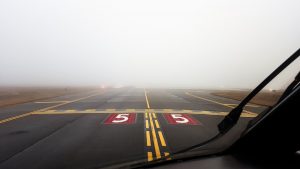 As any experienced pilot knows, planes take off into the wind. Whether it’s a small cessna 172 or a massive Airbus A380, pilots typically take off into the wind instead of with it.
As any experienced pilot knows, planes take off into the wind. Whether it’s a small cessna 172 or a massive Airbus A380, pilots typically take off into the wind instead of with it.
Conventional wisdom may lead you to believe that taking off into the wind increases resistance, slowing the plane down while forcing it to burn more fuel for energy. However, there’s a good reason for this strategic decision.
Basically, taking off into the wind allows pilots to achieve a higher altitude in less time, and with less speed. According to Snorri Gudmundsson, assistant professor of aerospace engineering at Embry-Riddle Aeronautical University, Florida, a Boeing 747 needs about 150 mph of airspeed to reach “wheels up.” If there’s little-to-no present, the plane must accelerate to 180 mph on the ground before lifting off. But with a 30 mph headwind, the plane only needs to reach 150 mph. So in essence, taking off into the wind provides additional lift, helping to rise the plane and allow it to takeoff more quickly.
It’s a little-known fact that some of the nation’s busiest airports are designed to allow pilots to take off into the wind. Hartsfield-Jackson Atlanta International Airport, for instance, features give runways running from east to west — the direction in which the wind blows. This allows pilots to take off into the wind; thus, reducing the speed needed to achieve “wheels up” and get off the runway.
United Captain Mike Bowers recently explained by saying the primary reason that we select a runway for takeoff is wind direction. When given the option, pilots choose to take off into the wind. With the wind flowing over the wing, the airplane has additional lift to help it become airborne. In essence, this reduces the amount of speed and distance needed to achieve “wheels up.” Of course, wind conditions aren’t always ideal for such takeoffs. If Mother Nature chooses to provide pilots with no wind, or wind at a different direction, they may not have the option to take off into the wind.
But pilots don’t just take off into the wind; they also land in it. This is for the very same reason. It allows pilots to land in a shorter distance as opposed to landing with the wind.
To recap, pilots take off into the wind because it reduces the required ground speed. Hopefully, this gives you a better understanding of why pilots take off into the wind.



